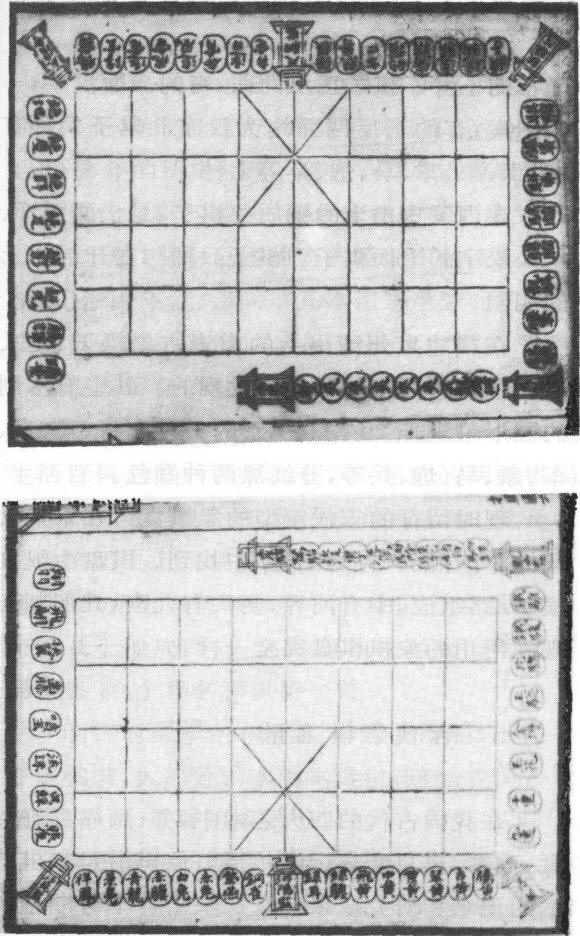Chapter 21 Section 4 Ancient Chessboards and Chess Pieces
In different historical periods of chess development, along with the reform and evolution of the chess system, there have been several major changes in the chess board and chess pieces.
The oldest chess board handed down now can be seen in the four artistic patterns of Qin, Chess, Calligraphy and Painting in Suzhou brocade in Tang and Song Dynasties.Chess is represented in the brocade, which is a square chessboard composed of 64 small black and white squares.This is exactly the chessboard shape of Tang Dynasty chess.Its shape is exactly the same as the modern chessboard, which proves that the ancient chess popular in the Tang Dynasty is different from the modern chess.

Suzhou Brocade, Qin, Chess, Calligraphy and Painting Patterns During the Tang and Song Dynasties
The ancient chess popular in the Tang Dynasty, the chess pieces are three-dimensional pictograms, which can be confirmed from the dream story about Cen Shun in the book "Xuanguailu" written by Niu Sengru, the prime minister of Tang Suzong.But until now, in the unearthed ancient tombs of the Tang Dynasty, no actual chess pieces of the Tang Dynasty have been unearthed.In the Tang Dynasty, chess pieces had only six types of arms: General, Soldier, Bishop, Chariot, Horse, and Pawn. Later, after the reform of Niu Sengru, a new type of artillery was added.
Between the end of Tang Dynasty and the Northern Song Dynasty, as a result of the great innovation of chess, the chessboard was changed to 11 vertical and horizontal lines, nine vertical lines and 10 horizontal lines, etc., and finally it was finalized into a chessboard with nine vertical lines and 10 horizontal lines used in modern chess.Chess pieces are changed into plane figures and plane fonts for both purposes, and finally finalized as plane fonts.Chess pieces are made of ivory, copper, and wood.
Chess pieces from the Song Dynasty have been found in ancient tombs being excavated in Inner Mongolia, Kaifeng, Henan, Jiangyou, Sichuan, and Quanzhou, Fujian.For example, the bronze chess pieces of the Northern Song Dynasty unearthed in Kaifeng, Henan Province. According to the identification of archaeologists, these chess pieces are relics of the Song Huizong period in the late Northern Song Dynasty.Chess pieces are made of brass, round, the largest diameter is 31 mm, the smallest is 11 mm, and there are still 20-30 mm.Chess pieces have both front and back sides, some have Chinese characters on one side and patterns on the other side; some have Chinese characters on both sides.There are seven types of chess pieces: General, Soldier, Bishop, Chariot, Horse, Cannon, and Pawn.

The dual-use board diagram of playing horse chess in "Da Ma Tu Jing"
The bronze chess pieces unearthed in Inner Mongolia are flat chess pieces with graphics on one side and Chinese characters on the other side.The arms of the chess pieces are the same as those unearthed in Kaifeng.
The ancient chess pieces of the Southern Song Dynasty unearthed in Quanzhou Bay, Fujian Province were found in the sunken ships of the Song Dynasty in Quanzhou Bay.Among them are 20 round wooden chess pieces.The arms of the chess pieces include generals, officials, soldiers, chariots, elephants, horses, cannons, soldiers, etc., and they are divided into two colors: red and black.
The remaining stereotyped chessboards of the Song Dynasty can be found in the Song Dynasty poetess Li Qingzhao's "Talking Horses and Tujing".The chessboard is composed of nine vertical and horizontal lines, with river boundaries in the middle and nine palaces at both ends. Its shape is exactly the same as that of the current chess board.

Suzhou Brocade, Qin, Chess, Calligraphy and Painting Patterns During the Tang and Song Dynasties

The dual-use board diagram of playing horse chess in "Da Ma Tu Jing"
